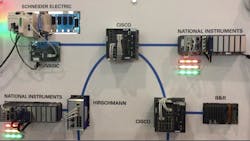Ethernet has been expanding onto plant floors around the world at a rapid pace for more than a decade now, despite the prevalence of installed fieldbus networks. Beyond the Internet connectivity enabled by Ethernet and its related security concerns, the biggest issue holding back even further expansion of Ethernet on the plant floor has been its inherent lack of determinism. The development and application of Time Sensitive Networking (TSN), via an update to the IEEE 802 standard, is focused on addressing that.
For background on TSN, see the links at the bottom of this article to explanatory articles from Automation World.
Key to the development of TSN for industry is proving its viability in real world scenarios—and that’s what the Industrial Internet Consortium’s (IIC) Time-Sensitive Networks testbed is all about. Participants in the testbed include: Bosch Rexroth, B&R Industrial Automation, Cisco, Innovasic, Intel, KUKA, National Instruments, Schneider Electric and TTTech.
The goal of the testbed, according to the IIC, is “to display the value of new Ethernet standards, referred to as Time Sensitive Networks, in a manufacturing ecosystem of applications. TSN enables a standard, single, open network infrastructure supporting multi-vendor interoperability and integration. The technology will be used to support real-time control and synchronization of high performance machines over a single, standard Ethernet network.”
Testbed participants are collaborating to:
- Combine different critical and best-effort traffic flows on a single network based on IEEE 802.1 Time Sensitive Networking;
- Demonstrate the real-time capability and vendor interoperability using standard, converged Ethernet;
- Evaluate the security value of TSN and provide feedback on the securability of initial TSN functions;
- Show ability for the Industrial Internet of Things (IIoT) to incorporate high performance and latency sensitive applications; and
- Provide integration points for smart edge and/or cloud control systems into IIoT infrastructure and applications.
The video below shows George Ditzel of Schneider Electric explaining the TSN tetsbed display at the IIC’s IoT Solutions World Congress 2016.
Recent Automation World articles on Time Sensitive Networking

